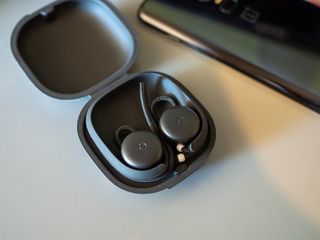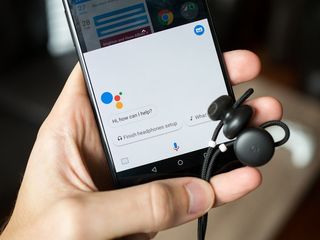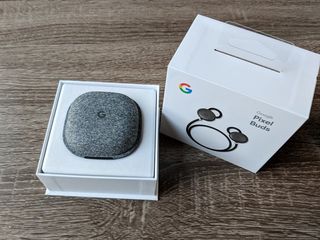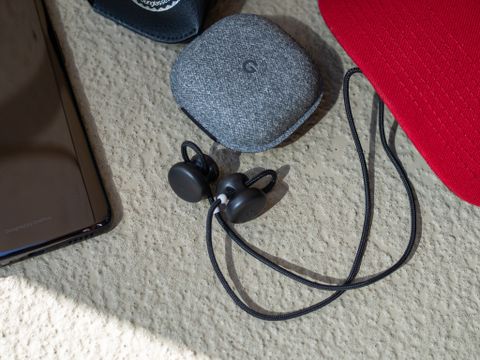Google's Pixel Buds headphones were launched alongside the Pixel 2 and a whole bunch of other products back at the end of 2017, and they have easily been the worst-received and least-hyped Google hardware product since. (Though Google Clips may disagree.) With the Pixel 2 lacking a headphone jack it only made sense for Google to make its own Bluetooth headphones — but it also added a bunch of advanced features with full touch controls, instant pairing, voice commands and the promise of seamless Google Translate functionality. The problem is, it didn't work all that well — but the price was still a steep $159.
I just took a vacation, spending a week in Mexico on beaches and golf courses relaxing and letting technology fall by the wayside. But in all of that time spent doing very little, I wanted to keep up with my podcasts, YouTube channels, and sports highlights, so I needed headphones — and I brought my Pixel Buds along. Here's what I've learned in my months of using them casually since launch, and a solid week using them as my only pair headphones.

The good parts
Google Pixel Buds What I like
Just as I found in my first week using them, the Pixel Buds nail the basics of being headphones. Despite their unorthodox design, the earbuds are extremely comfortable for long listening sessions. They're very light, settle in your ears gently and fit well once you get the hang of adjusting the cord mechanism.

Unlike so many other earbuds, the Pixel Buds don't go in your ear with a rubber tip, but instead rest gently on a couple of points of your ear and have a driver pointed toward your ear canal. This means the Pixel Buds are compatible with far more ear sizes and shapes (particularly if you have mismatched ear sizes), and don't require a set of removable tips to get a good fit. Even with the cord on my neck, I never had discomfort even after hours of continuous listening.
And the lack of deep in-ear placement has the added benefit of not transferring noise from the cord back into your ears — whether I was walking, jogging or hitting golf balls at the driving range, my movements never brought scratchy interference to the audio. That likely contributes to the fact that I really like how the Pixel Buds sound — at least, as far as Bluetooth headphones go. Sure you get a little more ambient noise mixed in, but the Pixel Buds get plenty loud to help cancel that out. And whether it was listening to podcasts or music, I never had an issue with the audio quality or bass compared to any typical pair of consumer earbuds. Phone calls on the Pixel Buds are great, too, and I never had a complaint from the person on the other end.
The Pixel Buds are extremely comfortable for long listening sessions, and fit a wide variety of ears.
Google's May update for the Pixel Buds dramatically improved the device switching process, which was previously cumbersome and antithetical to the "just open the case and use them" goal. Now all you have to do to switch connections is initiate the connection from a previously-paired device, and the Pixel Buds will always change to it. Overall I prefer this method of forcing the connection from the sending device's end over cycling through paired devices with taps and clicks (or an app) on the headphone's end. Initial pairing is, of course, still an absolute breeze on any Android phone using Fast Pair — and on a computer, it's the same as any other pair of Bluetooth headphones.
With the Pixel Buds and their case fully charged prior to leaving, I made it through my entire week in Mexico without plugging them in. Just casually using them for an hour or two here and there, swapping between my phone and MacBook, I never had to pause to charge when I'd prefer to be listening. Google rates the Pixel Buds for 5 hours of listening on their own, and I can't think of many situations where I need to have wireless earbuds in for 5 hours straight — aside from a long plane ride, at which point I upgrade to my Bose QC35s anyway.
The case may seem annoying at first, but the battery life freedom it offers is worth it.
The case is rated for another 4 to 5 charges, which is plenty. Carrying the case is in some ways more cumbersome than just the earbuds, but knowing that every time I take the Pixel Buds out they have a 100% charge vastly outweighs the downsides. With the battery life I've experienced, I'm charging the Pixel Buds case once for every 30 hours of listening ... every other small pair of earbuds that charges independently won't get anywhere near that number. (And a little pro tip: you can even charge the Pixel Buds case via USB-C from your phone in a pinch.)
I have some complaints about the Pixel Buds charging case, but they're outweighed by the positives. The fabric looks great, feels fantastic, and despite my fears hasn't faded or stained after months of use. The hinge is still taught after hundreds of opens and closes, and the magnet has proven to be strong enough to keep the case closed when tumbling around in a beach bag with a whole bunch of other stuff.

Does not translate
Google Pixel Buds What's not good
Google's promise of seamless live translation of multiple languages using the Pixel Buds just never panned out. It didn't even demo particularly well, and in the real world it effectively doesn't work at all — both technologically and, more importantly, socially.
When I'm standing at a street vendor in Mexico trying to order a couple tacos and a beer (which I did often, as you'd imagine), the guy behind the counter isn't going to wait 30-plus seconds for me to fire up my Pixel Buds, ask it to translate, and then stick my phone out so the conversation is heard. Hand gestures and a mix of English and limited Spanish is going to get me much further in that transaction in a fraction of the time — or at the very most I can ask for a moment of their time to use the Google Translate app on my phone.

Even if the translation feature was flawlessly implemented, which it's extremely far from being, there's still a social barrier to talking to another person while wearing headphones. For as small as these earbuds are, they're still plenty noticeable — and the cord dangling on your neck is a dead giveaway that you have a device on you. Having earbuds in is the universal sign for "I don't want to hear you right now," and initiating an interaction in which you don't speak someone else's language by walking up with headphones in your ears is not a good idea.
But put the admittedly niche translation feature aside — there are many other more practical issues with the Pixel Buds that everyone will have to deal with. The biggest problem is their reliance on touch controls for every interaction. There's a single tap for play/pause, a double tap for advanced functions, a press-and-hold for Assistant, and a swipe forward/back for volume control ... all on a tiny earbud that doesn't fit firmly in your ear. It's a recipe for frustration, and even with how long I've used the Pixel Buds I haven't been able to get it to work consistently.
Even after months of use, these touch controls are still a disaster.
The play/pause tap is the easiest of the bunch, but because the earbud is so small it's impossible to get 100% of the time. If your finger is wet at all, for example if you just set down your condensation-laden cold beer can, you have less than a 50-50 chance of registering the tap. No matter if your finger is dry, forward/back swipes for volume control are often registered as a single tap, pausing your audio, or as a long press, activating Assistant. Any hesitation or missed aim on an intentional long-press is registered as a double tap.
My longest-held frustration with the Pixel Buds' touch controls was the propensity for accidental touch activation when handling them between the case and my ears, which has just now been rectified. An update in early May lets you manually turn off or on the Pixel Buds with a quick triple-tap of the right earbud, so you can safely dangle the earbuds around your neck or pop them in their case without accidentally turning back on your music. Rumor has it that Google is working on a way for the Pixel Buds to detect when they're removed from your ear and pause audio, which would be the preferred method to do this considering they're supposed to be "smart," but the triple-tap has removed a huge amount of frustration with accidental touches.
The latest software update fixed some of the biggest flaws, but there are hardware issues here that can't be addressed.
And speaking of those smarts, much like the translation feature, Google Assistant hasn't been a regular feature put to use with my Pixel Buds. Yes it works for the typical knowledge-style questions — like what the weather is like this afternoon, or what your next appointment is — but isn't well-suited to headset controls like skipping tracks or playing different media. And for most voice commands, the response I get will be better handled by just taking my phone out of my pocket rather than dealing with long sequences of voice controls, audio feedback and pauses.
A totally unexpected issue I found over time is how the cord connecting the earbuds aged. Because of the little twist and tuck you have to do with the earbuds' cord to get it placed just so in the charging case, my Pixel Buds cord has developed a curve and kink in the middle of it where you have to pinch to perform the move. This tight bend never flattens out again, and it means that if you twist either of the earbuds in the process of putting them in your ear the cord doesn't sit on your neck properly and is bothersome. The cord is tough, and in no way fragile, but the downside is that it's too stiff to be flexible (literally and figuratively) with how you deploy it.

Great ideas, poor execution
Google Pixel Buds Review
The Pixel Buds are frustrating to review because they're such a typically "Google" product. They have a unique and thoughtful design that's comfortable, intuitive and has a few "wow" features. But they're encumbered by the frustration of the core touch interface not being implemented well and major advanced features that hardly work at all.
As a pair of Bluetooth headphones, the Pixel Buds absolutely nail the basics. The sound quality is quite good, they're comfortable to use for hours at a time, the pairing and connection process is simple, and the charging case frees you from battery anxiety and has unexpectedly even held up to months of use. But Google's implementation of a touch control system is a disaster, and is even less forgivable when there's still a cord attached to the earbuds that could easily incorporate in-line button controls. The "smart" parts of these earbuds underwhelm every step of the way, and while some have been fixed in software others remain half-baked or unable to be fixed with just an update.
The Good
- Comfort is truly fantastic
- Sound is above average for earbuds
- Battery life is great with the case
- Pairing and changing devices is a breeze
- Case has held up over several months
The Bad
- Touch controls are a disaster
- Cord gets kinked and twisted
- Assistant commands have limited use
- Live translation is effectively useless
- Expensive considering lackluster features
3 out of 5
If the Pixel Buds were less expensive, perhaps $79, I could look past the cumbersome touch controls, useless translation feature and questionable "smart" functionality. But if you take away all of the advertised advanced features Google advertises with the Pixel Buds, charging $159 for what are then essentially dumb Bluetooth earbuds is a tough ask. The Pixel Buds are extremely comfortable, sound good and have long battery life, but so do lots of other Bluetooth headphones that are $50 or even $100 less.
There are lots of great ideas here. If the execution were better there may be some sort of justification of the higher price, at least when added to the basic things they do really well, but as it stands you just can't expect people to pay this much for the Pixel Buds.
Andrew was an Executive Editor, U.S. at Android Central between 2012 and 2020.


